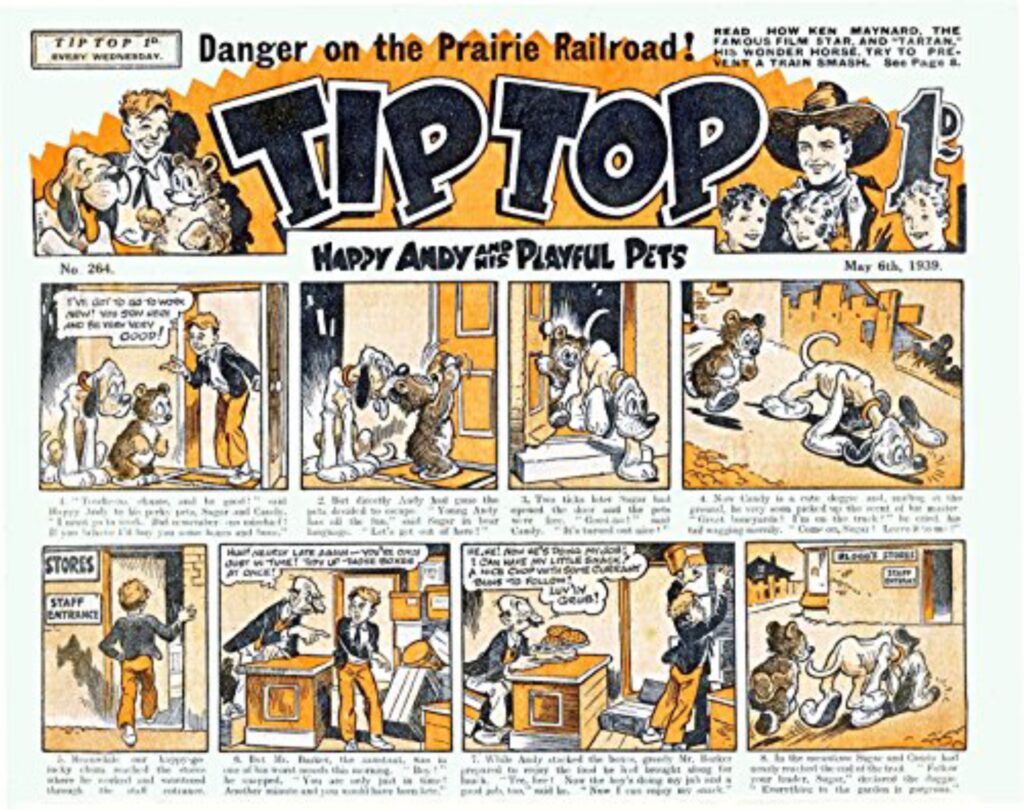The Amalgamated Press (AP) was a prominent British newspaper and magazine publishing company established by journalist and entrepreneur Alfred Harmsworth (1865–1922) in 1901. Alfred Harmsworth consolidated his various publishing ventures under the banner of Amalgamated Press, making it one of the largest publishing companies globally at the time.
The company boasted a roster of notable writers, including Arthur Mee, John Alexander Hammerton, Edwy Searles Brooks, and Charles Hamilton. Additionally, its subsidiary, the Educational Book Company, published several well-known educational works, such as The Harmsworth Self-Educator, The Children’s Encyclopædia, and Harmsworth’s Universal Encyclopaedia. AP’s newspapers included the Daily Mail, the Daily Mirror, The Evening News, The Observer, and The Times. AP published over 70 magazines at its zenith and operated three significant printing works and paper mills in South London.
| Amalgamated Press | |
|---|---|
| Predecessor | Harmsworth Brothers Ltd |
| Founded | 1901 |
| Founder | Alfred Harmsworth |
| Defunct | 1959 |
| Successor | International Publishing Company (IPC) |
| Country of origin | England |
| Headquarters location | Fleetway House (from 1912) |
| Key people | Harold Harmsworth, William Berry, Seymour Berry |
| Editors | Reg Eves, John Alexander Hammerton, Leonard Matthews, Charles Ray, Henry Beckles Willson |
| Writers | Herbert Allingham, Edwy Searles Brooks, Henry St. John Cooper, Charles Hamilton, Arthur Mee, Frank S. Pepper, Hugo Tyerman |
| Artists | Freddie Adkins, Alex Akerbladh, John Jukes, Frank Minnitt |
| Publication types | Newspapers, story papers, comics, magazines, paperbacks |
| Imprints | The Educational Book Company |
| Owner(s) | Alfred Harmsworth (1890–1922), Allied Newspapers (1926–1937), William Berry (1937–1959), IPC (1959) |

Harmsworth Brothers Ltd
Alfred Harmsworth and his younger brother Harold (1868–1940) established Harmsworth Brothers in 1888, with Alfred as the publisher and Harold managing the finances. Their first venture was Answers to Correspondents, a paper modeled after the popular publication Tit-Bits. In 1890, Harmsworth entered the comic magazine market with Comic Cuts and Illustrated Chips.
The comic Wonder, launched in 1892, was part of a series of connected titles that continued until 1953, with names like Funny Wonder and Jester. Concurrently, Harmsworth began publishing periodicals to rival the penny dreadfuls, offering cheaper and more respectable story papers priced at one halfpenny. These papers, including Halfpenny Marvel and The Union Jack, initially featured high-minded moral tales but eventually adopted content similar to their competitors.

1894 the Harmsworth brothers expanded into the newspaper business by acquiring The Evening News and the Edinburgh Daily Record. Alfred Harmsworth founded the highly successful Daily Mail in 1896, which set a world record for daily circulation. The brothers also launched Home Chat, a women’s magazine, to compete with existing publications.

Formation and Expansion of Amalgamated Press
In 1901, Alfred Harmsworth consolidated his publishing ventures under the banner of Amalgamated Press. The following year, the company established offices in Manchester and implemented a streamlined layout and printing process using codes and telegraphs. Expanding his newspaper empire, Harmsworth initiated the Daily Mirror in 1903 and acquired financially struggling publications like The Observer and The Times in subsequent years. By 1908, Amalgamated Press had acquired The Sunday Times as well.
The quality of AP’s story papers improved over the early 20th century, with titles like The Gem and The Magnet dominating the UK market by the time of World War I. Recognizing the popularity of story papers among girls, AP launched a line of girls’ papers, including School Friend and The Schoolgirl.
In 1912, Amalgamated Press established its headquarters at Fleetway House in Farringdon Street, London. The company expanded its operations by acquiring the assets of James Henderson & Sons Ltd in 1920. However, AP faced increased competition in the 1930s with the emergence of rival publishers like DC Thomson, known for titles such as The Hotspur.

Harmsworth’s Death; Allied Newspapers; William Berry
Alfred Harmsworth passed away in 1922, and in 1926, Amalgamated Press was acquired by William and Gomer Berry of Allied Newspapers. Shortly after the acquisition, AP purchased and continued publishing several periodicals from Cassell & Co., including Cassell’s Magazine and The Story-Teller.
The partnership between the Berry brothers dissolved in 1937, with William Berry (Lord Camrose) retaining control of Amalgamated Press. Leonard Matthews, who joined AP in 1939, played a significant role in the company’s comics titles for two decades.
World War II significantly changed AP’s comics line, with several long-running titles merged or canceled. Seymour Berry, 2nd Viscount Camrose, served as Vice Chairman of Amalgamated Press from 1942 until the company’s sale in 1959.
1949 AP acquired publisher J. B. Allen, including their comics titles The Comet and Sun. Throughout the 1950s, AP launched notable comics such as School Friend, Lion, Tiger, and the children’s comics Jack and Jill and Playhour.

Acquisition by the Mirror Group/IPC
In 1959, the Mirror Group purchased Amalgamated Press and renamed it Fleetway Publications after its headquarters, Fleetway House. Several AP titles were continued by IPC/Fleetway, including School Friend, Lion, Playhour, Tiger, and Valentine. However, other titles, such as The Comet, Sun, and Tiny Tots, were merged into existing AP titles.
1961 the Mirror Group acquired Odhams Press, forming the International Publishing Corporation in 1963. The component companies continued using their names until 1968, when they were reorganized into IPC Magazines. The “Fleetway” banner persisted for some publications until IPC’s comics line was sold to Robert Maxwell in 1987.
Rebellion Developments owns all comics characters and titles created by IPC’s subsidiaries after January 1, 1970. Meanwhile, IPC retains its other comic characters and titles, including Sexton Blake, The Steel Claw, and Battler Britton.

Conclusion
The Amalgamated Press played a pivotal role in shaping the landscape of British publishing during the 20th century. Under the leadership of Alfred Harmsworth and later the Berry brothers, AP became a powerhouse in the industry, producing a wide array of newspapers, magazines, and comics. While the company underwent various mergers and acquisitions over the years, its legacy continues to influence today’s publishing world.
Frequently Asked Questions (FAQs) about Amalgamated Press:
1. What was Amalgamated Press?
– Amalgamated Press (AP) was a prominent British newspaper and magazine publishing company founded by Alfred Harmsworth in 1901. It became one of the largest publishing companies in the world during its heyday.
2. What publications did Amalgamated Press produce?
– AP published many newspapers, magazines, periodicals, and story papers. Some of its notable publications included the Daily Mail, the Daily Mirror, The Evening News, The Observer, The Times, and numerous comic magazines and story papers.
3. Who were some of the notable writers associated with Amalgamated Press?
– AP employed writers such as Arthur Mee, John Alexander Hammerton, Edwy Searles Brooks, and Charles Hamilton. These writers contributed to various publications under the AP banner.
4. What were some of the popular comic magazines and story papers produced by Amalgamated Press?
– AP published several popular comic magazines and story papers, including Comic Cuts, Illustrated Chips, The Gem, The Magnet, Pluck, and Thriller. These publications catered to a broad audience, including children and young adults.
5. What was the significance of Amalgamated Press in British publishing history?
– Amalgamated Press played a significant role in shaping the landscape of British publishing during the early to mid-20th century. It introduced innovative publishing practices, produced a wide range of popular publications, and contributed to the growth of the newspaper and magazine industry in the UK.
6. What happened to Amalgamated Press?
– In 1959, Amalgamated Press was bought by the Mirror Group and renamed Fleetway Publications. Subsequently, it underwent several mergers and acquisitions before eventually being sold to Robert Maxwell in 1987. Today, the legacy of Amalgamated Press lives on through its iconic publications and contributions to British publishing history.
7. What impact did Amalgamated Press have on the comic book industry?
– Amalgamated Press played a significant role in popularizing comic magazines and story papers in the UK. It introduced beloved characters and series that captured the imagination of generations of readers. Additionally, AP’s innovative storytelling and publishing techniques influenced the development of the comic book industry in Britain.
8. Are any of Amalgamated Press’s publications still in print today?
– While many of Amalgamated Press’s original publications are no longer in print, modern publishers have revived or reimagined some. Additionally, the characters and stories introduced by AP continue to be celebrated and referenced in contemporary media, showcasing the enduring legacy of this iconic publishing company.
9. What can we learn from the history of Amalgamated Press?
– The history of Amalgamated Press provides valuable insights into the evolution of the publishing industry, the impact of popular culture on society, and the role of media in shaping public opinion. By studying AP’s legacy, we gain a deeper understanding of the cultural, social, and economic forces that have shaped modern media landscapes.
10. Where can I learn more about Amalgamated Press and its publications?
– Various resources, including books, articles, and online archives, provide detailed information about Amalgamated Press and its publications. Additionally, libraries, museums, and academic institutions may have collections or exhibitions dedicated to AP’s legacy, offering further opportunities for exploration and research.
This post was created with our nice and easy submission form. Create your post!




2 Comments